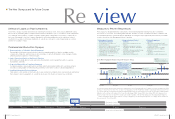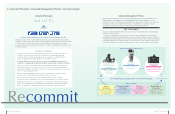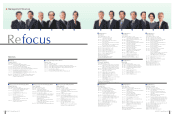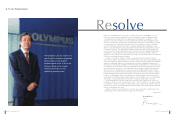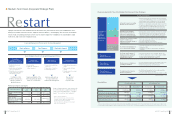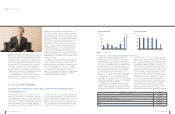Olympus 2013 Annual Report Download - page 13
Download and view the complete annual report
Please find page 13 of the 2013 Olympus annual report below. You can navigate through the pages in the report by either clicking on the pages listed below, or by using the keyword search tool below to find specific information within the annual report.
22 OLYMPUS Annual Report 2013 23OLYMPUS Annual Report 2013
Incident regarding Deferred Posting of Past Losses
How has Olympus changed? After the scandals, what measures should Olympus institute, and how should it
target future growth? President Hiroyuki Sasa conversed with analysts that have observed Olympus for a number
of years with regard to the expectations of the Company and the challenges it faces, receiving their earnest
opinions and advice. (Conversation held on June 10, 2013, in a meeting room of the Company’s head of ce)
Masahiro Nakanomyo
Managing Director
Barclays Securities Japan
Limited
Profile
Mr. Nakanomyo joined The
Mitsubishi Banking Corp. in
1984, where he undertook
a variety of industry and
corporate research projects
over a 25-year period. In
2009, he joined Barclays
Securities Japan and leads
the precision instrument
sector coverage team in the
equity research section.
J.P. Morgan Securities Plc.
Hisashi Moriyama
Goldman Sachs Japan Co., Ltd.
Toshiya Hari
President and Representative Director
Hiroyuki Sasa
Barclays Securities Japan Limited
Masahiro Nakanomyo
Toshiya Hari
Managing Director
Global Investment Research,
Goldman Sachs Japan Co., Ltd.
Profile
Mr. Hari joined Goldman Sachs
Japan in 2001 after graduating
from the London School of
Economics and Political
Science. After several years
in a supporting role as junior
analyst, he became the lead
analyst for the Semiconductor
Capital Equipment sector in
2007 and for the Precisions
sector in 2009.
Hisashi Moriyama
Senior Analyst
Equity Research Division,
J.P. Morgan Securities Plc.
Profile
Mr. Moriyama began his career at
New Japan Securities Inc. After
eight years in sales, he was
transferred to the company’s
investment study department.
Later, he joined the Tokyo Branch
of Credit Lyonnais Securities Asia,
where he was responsible for the
precision equipment and electronic
components sectors. In 2002, he
entered J.P. Morgan Securities
and was placed in charge of the
precision equipment sector.
Sasa I would like to begin by
apologizing for the great inconvenience
and concern we caused through the
scandals that were discovered in the year
before last. I was quite surprised when
this issue surfaced, and I feared Olympus
itself may cease to exist. At that time, I was a division
manager in charge of marketing for the entire Medical
Business. To reassure my subordinates after the issue
surfaced, I reminded them of the Company’s solid operating
foundations exemplifi ed by its endoscopes. There was no
way this foundation would just disappear. Even if Olympus
ceases to exist, endoscopes will never vanish. Drawing
their attention to this fact, I encouraged them to focus on
maintaining business operations and to fi ght for the
Company’s survival in their own way.
In all, the development and manufacturing staff were
relatively calm. They were confi dent that their endoscopes
would not disappear, and they continued to supply us
with high-quality products and services steeped in this
confi dence. Meanwhile, the sales staff was subjected to a
fl urry of inquiries and questions from physicians, receiving
both reprimand and encouragement. Even under these
The Creation of a New Olympus and Future Growth—Conversation with Analysts
harsh circumstances, they remained devoted to recovering
the trust of the Company, and thus helped us pull through
this diffi cult period. In January 2012, it was decided that
Olympus would remain listed on the Tokyo Stock
Exchange. At that moment, I felt assured that we could
return Olympus to glory if we remained committed.
Nakanomyo With regard to the deferred
posting of past losses, I feel this incident
was partially due to the failure of us, as
analysts, in performing our duties. I think
there was an extent to which this issue
could have been predicted before the
discovery of the misrepresentation from the Company’s
disclosed fi nancial information. Regardless, the incident
caught us all by surprise. As participants in the capital
market, it is our duty to monitor such activities, and I feel
responsibility in my failure to do so. At the same time,
there is a nagging sense of disbelief directed toward the
Company that still remains today. I believe it will be up to
Olympus to dispel this disbelief through its future actions.
At the very least, this disbelief partially vanished after you
were appointed as president, Mr. Sasa.
Moriyama When the issue surfaced, I
was fi lled with disappointment and anger,
as though I had been betrayed by a friend
of many years or someone else I deeply
trusted. To be perfectly honest, I feel
that the Company’s actions were greatly
disappointing, whether viewed from the perspective of the
Japanese stock market or the rest of the world. I had no
choice but to stop covering Olympus as a result. However,
over the year that followed the change in management,
a number of statements were released by Olympus. In
particular, I felt that the announcement of measures for
restructuring the Imaging Business in May 2013 best
communicated the Company’s sincerity. The announcement
was simple yet moving. Quite frankly, I did not expect
Olympus to put out any statements that exceeded the
expectations of the market. However, when I saw the plan
to halve compact camera sales targets, making for a target
that is unprecedentedly low by the Company’s standards,
my opinion immediately took a position swing. My view of
Olympus has nearly completed a 180-degree turn from a
year ago.
Sasa The impacts of this issue are not limited to the
Company. Rather, these impacts also weigh heavily on the
Japanese stock market. As such, how Olympus should go
about regaining the trust of the market was a matter we
worried much over. It was determined that accomplishing
the goals of the medium-term vision was of utmost priority.
We realized that if we cannot accomplish the fi gures set out
in the plan, then it will be impossible to recover trust. Now,
one year later, I still cannot say that Olympus has changed
suffi ciently. Looking at our fi nancial position, the equity ratio
has only recovered to around 16%, and this is far from
enough. We are also faced with the major management
task of returning the Imaging Business to profi tability. For
these reasons, I think we can say that we are still not
effectively producing results. Nevertheless, what we must
do remains clear. Our mission now is to steadily address
the tasks we face one at a time.
Hari We upgraded our rating
on Olympus two days before Michael
Woodford was removed from his position
as president and CEO, and I remember
becoming quite emotional after the
incident surfaced. At the same time,
I blamed myself for my inability to catch on to the
misrepresentation through disclosure materials, which,
while perhaps diffi cult, could not have been impossible to
see. After you were appointed as president, Mr. Sasa, the
speed at which the Company’s governance systems and
business portfolio improved has been startling, with much
being accomplished in a short period. Next, I hope you will
shift your focus to achieving further growth in the Medical
Business. While discussion tends to be directed toward
what will be done in the Imaging Business and the Others
Business, I feel that the Company’s core business remains
as the Medical Business.
Refl ect


